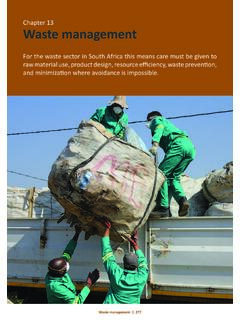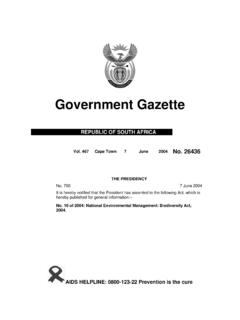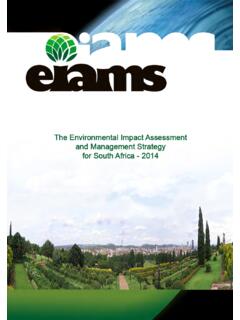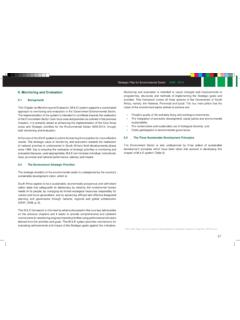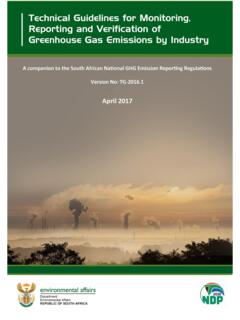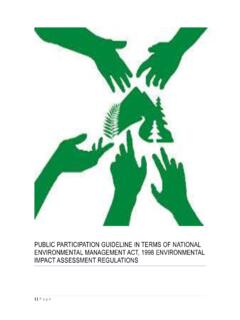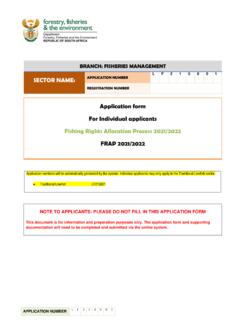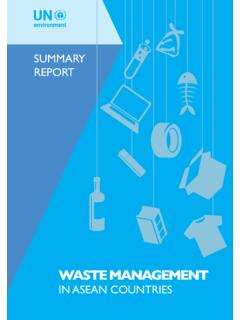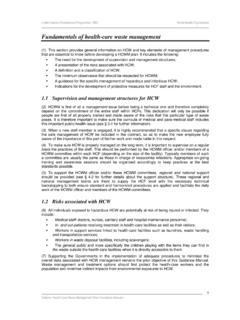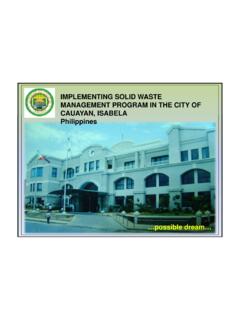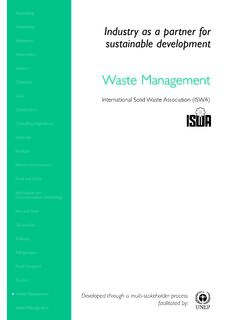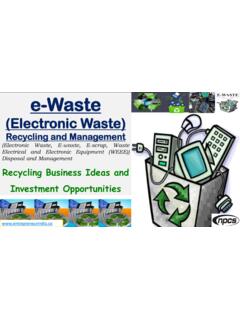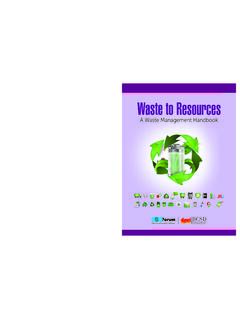Transcription of National Waste Management Strategy
1 National Waste Management Strategy November 2011 National Waste Management Strategy Page 2 of 75 Table of Contents Executive Summary .. 5 1. Background .. 10 Introduction .. 10 Approach and methodology .. 11 Constitutional and legal framework .. 12 Definition and scope .. 13 International obligations .. 14 Problem statement .. 14 2 Overall approach for NWMS .. 16 Introduction .. 16 Link to Government-wide Monitoring and Evaluation System .. 17 Waste Management Hierarchy .. 18 Partnerships and 19 Regulatory model .. 20 Description of goals .. 20 3 Instruments for implementing the NWMS .. 38 Introduction .. 38 Waste classification and Management system .. 38 Norms and standards .. 40 Licensing Waste Management Activities .. 42 Industry Waste Management Plans .. 45 Extended Producer Responsibility .. 47 Priority wastes .. 50 Economic instruments.
2 52 4 Implementation .. 54 Introduction .. 54 The role of the private sector .. 54 The role of civil society .. 54 The role of government .. 55 Co-operative governance .. 58 Waste Management Officers .. 59 Capacity building .. 61 Waste Information System .. 62 Monitoring and evaluation .. 63 Mechanisms to give effect to international obligations .. 65 5 Conclusion .. 68 Appendix One: Action Plan .. 69 National Waste Management Strategy Page 3 of 75 Index of Figures Figure 1: Waste Management 23 Figure 2: NWMS tool box of measures .. 206 Figure 3: Process for declaring an EPR programme .. 63 Figure 4: Decision Making Process for Declaring Priority Wastes .. 66 Figure 5: Coordination mechanisms for WMOs .. 79 Index of Tables Table 1: Summary of NWMS Goals .. 6 Table 2: Phases for developing the NWMS .. 11 Table 3: Role players contribution to re-use, recycling and recovery of Waste .
3 23 Table 4: Goals, objectives, indicators and targets for the NWMS .. 35 Table 5: Roles of government departments .. 57 Table 6: Responsibilities of National , Provincial and Local WMOs .. 60 Table 7: New capacity required to implement the Waste Act .. 61 Table 8: Reporting requirements for IWMP annual performance reports .. 65 National Waste Management Strategy Page 4 of 75 List of Abbreviations DCOG Department of Cooperative Governance DEA Department of Environmental Affairs DTI Department of Trade and Industry DMR Department of Mineral Resources DWA Department of Water Affairs ECA Environment Conservation Act EIA Environmental Impact Assessment EMI Environmental Management Inspector EMPR Environmental Management Programme EPR Extended Producer Responsibility IDP Integrated Development Plan IndWMP Industry Waste Management Plan ITAC International Trade Agreement Commission IWMP Integrated Waste Management Plan MEA Multilateral Environmental Agreement MEC Member of Executive Council NEAS National Environmental Authorisation System NEMA National Environmental Management Act NGO Non-Governmental Organisation NWMS National Waste Management Strategy POP
4 Persistent Organic Pollutant PPP Public Private Partnership SABS South African Bureau of Standards SADC Southern African Development Community SANAS South African National Accreditation System SANS South African National Standards SARS South African Revenue Service SAWIS South African Waste Information System SMME Small, Medium and Micro Enterprise WCMS Waste Classification and Management System WEEE Waste of Electric and Electronic Equipment WIS Waste Information System WMO Waste Management Officer Executive Summary The National Waste Management Strategy (NWMS) is a legislative requirement of the National Environmental Management : Waste Act, 2008 (Act No. 59 of 2008), the Waste Act . The purpose of the NWMS is to achieve the objects of the Waste Act. Organs of state and affected persons are obliged to give effect to the NWMS. Waste Management in South Africa faces numerous challenges and the NWMS provides a plan to address them.
5 The main challenges are: 1. A growing population and economy, which means increased volumes of Waste generated. This puts pressure on Waste Management facilities, which are already in short supply. 2. Increased complexity of Waste streams because of urbanisation and industrialisation. The complexity of the Waste stream directly affects the complexity of its Management , which is compounded by the mixing of hazardous wastes with general Waste . 3. A historical backlog of Waste services for, especially, urban informal areas, tribal areas and rural formal areas. Although 61%1 of all South African households had access to kerbside domestic Waste collection services in 2007, this access remains highly skewed in favour of more affluent and urban communities. Inadequate Waste services lead to unpleasant living conditions and a contaminated, unhealthy environment.
6 4. Limited understanding of the main Waste flows and National Waste balance because the submission of Waste data is not obligatory and where available is often unreliable and contradictory. 5. A policy and regulatory environment that does not actively promote the Waste Management hierarchy. This has limited the economic potential of the Waste Management sector, which has an estimated turnover of approximately R10 billion per annum2. Both Waste collection and the recycling industry make meaningful contributions to job creation and GDP, and they can expand further. 6. Absence of a recycling infrastructure which will enable separation of Waste at source and diversion of Waste streams to material recovery and buy back facilities. 7. Growing pressure on outdated Waste Management infrastructure, with declining levels of capital investment and maintenance.
7 1 Stats SA Community Household Survey 2007 refuse removal data on kerbside collection. 2 Michael Goldblatt of Palmer Development Group, Macroeconomic trends, targets and economic instruments , paper prepared for Department of Environmental Affairs as part of NWMS process, August 2009 National Waste Management Strategy Page 6 of 75 8. Waste Management suffers from a pervasive under-pricing, which means that the costs of Waste Management are not fully appreciated by consumers and industry, and Waste disposal is preferred over other options. 9. Few Waste treatment options are available and so they are more expensive than landfill costs. 10. Too few adequate, compliant landfills and hazardous Waste Management facilities, which hinders the safe disposal of all Waste streams.
8 Although estimates put the number of Waste handling facilities at more than 20003, a significant number of these are unpermitted. The objects of the Waste Act are structured around the steps in the Waste Management hierarchy, which is the overall approach that informs Waste Management in South Africa. The Waste Management hierarchy consists of options for Waste Management during the lifecycle of Waste , arranged in descending order of priority: Waste avoidance and reduction, re-use and recycling, recovery, and treatment and disposal as the last resort. The NWMS is structured around a framework of eight goals, which are listed in table 1 Error! Reference source not found. together with the targets for each goal that must be met by 2016: Table 1: Summary of NWMS Goals Description Targets (2016) Goal 1: Promote Waste minimisation, re-use, recycling and recovery of Waste .
9 25% of recyclables diverted from landfill sites for re-use, recycling or recovery. All metropolitan municipalities, secondary cities and large towns have initiated separation at source programmes. Achievement of Waste reduction and recycling targets set in IndWMPs for paper and packaging, pesticides, lighting (CFLs) and tyres industries. Goal 2: Ensure the effective and efficient delivery of Waste services. 95% of urban households and 75% of rural households have access to adequate levels of Waste collection services. 80% of Waste disposal sites have permits. Goal 3: Grow the contribution of the Waste sector to the green economy. 69 000 new jobs created in the Waste sector 2 600 additional SMEs and cooperatives participating in Waste service delivery and recycling 3 DEAT (2007), Assessment of the Status of Waste Service Delivery and capacity at Local Government level.
10 Directorate: General Waste Management , August 2007, Draft 3. National Waste Management Strategy Page 7 of 75 Description Targets (2016) Goal 4: Ensure that people are aware of the impact of Waste on their health, well-being and the environment. 80% of municipalities running local awareness campaigns. 80% of schools implementing Waste awareness programmes. Goal 5: Achieve integrated Waste Management planning. All municipalities have integrated their IWMPs with their IDPs, and have met the targets set in IWMPs. All Waste Management facilities required to report to SAWIS have Waste quantification systems that report information to WIS. Goal 6: Ensure sound budgeting and financial Management for Waste services. All municipalities that provide Waste services have conducted full-cost accounting for Waste services and have implemented cost reflective tariffs.
